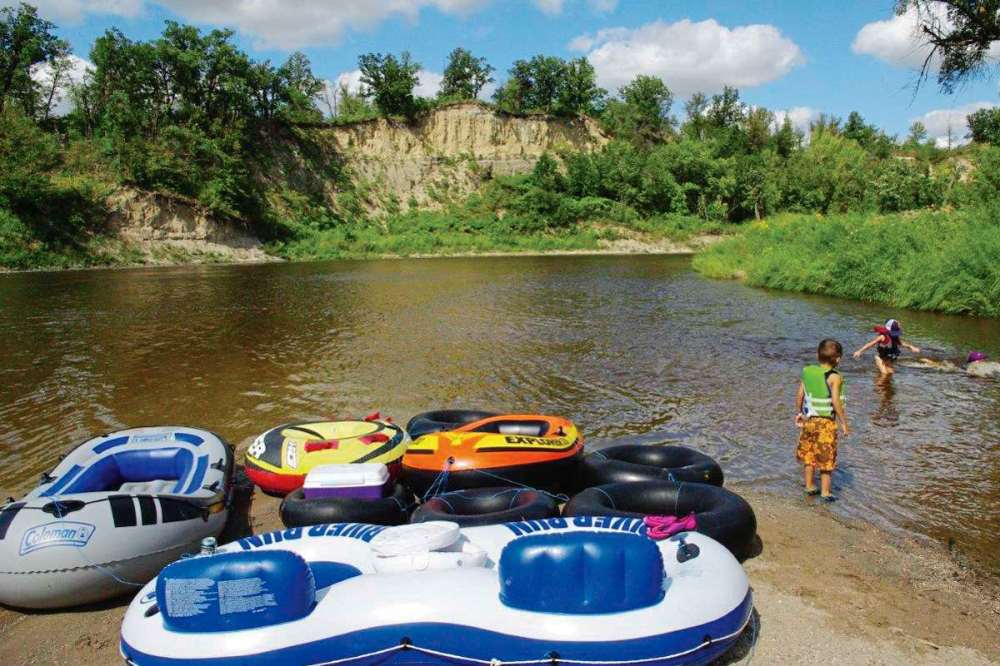Fond memories of Red Lake Falls
Advertisement
Hey there, time traveller!
This article was published 03/07/2017 (3114 days ago), so information in it may no longer be current.
Back in the day, tubing was a summertime tradition we couldn’t get enough of. My circle of friends, and much of my family, too, would convoy from Manitoba down to Minnesota to spend weekends partaking in this particular ritual.
If you’re not familiar with tubing, the concept is simple. You sit in an inflated inner tube, tied to other inner tubes with other people in them, with another smaller tube holding your cooler. Once you’re all interconnected, and cold beverages are safely stowed within easy reach, you push off from shore and away you go, floating down the river for the next few hours in one big happy flotilla. That is how tubing is done.
The best place I know of to do this is Red Lake Falls. It’s a small town with a traditional feel, old brick buildings, and wide streets. There are no traffic lights here, and locals joke that people stop in Red Lake Falls because they want to, not because they have to.

The town has an interesting history tied to Winnipeg, as the site of a 1798 Northwest Company trading post. It was here Voyageurs transported supplies down the Red Lake River, to the Red River, eventually reaching the Red River Colony. Today, commercial activity still exists between Red Lake Falls and Winnipeg, with the most obvious connection being recreational.
Voyageur’s View, just north of town, started its business back in 1985. It now offers kayaking, fishing, volleyball courts and playground area, in addition to their biggest attraction: the 6.5-kilometre tubing run. It’s a popular summer pastime, and the owners estimate that 40 per cent of their tubing traffic comes from Manitoba, their “friends from the north.”
While it has been many years since I ventured out in an inner tube, I decided to tag along with some family last summer. Voyageur’s View is now run by the grown-up kids of the couple who used to run it back in the day. There are still hundreds of photos on the wall displaying sun-kissed faces of happy campers from yesteryear. We managed to find a photo of my brother, his wife, and my little dog, too, who was small enough to fit inside her own cooler tube.
Being on the Red Lake River again, 30 years after my first visit, truly felt nostalgic. It’s like time somehow stood still on that always-moving current. Except this time we floated with fewer cold ones, less rowdy ones, and a much bigger gaggle of little ones. We belted out group songs, told ridiculous jokes, laughed out loud, and made way too much noise. We hugged the kiddies close when the rapids got too scary, stopped on “the island” to stretch our tubing legs, dug holes in the sand for tall people to stand in, and searched the shoreline for beach treasures.
I have to say, it turned out to be just as much fun — maybe even moreso — to see the next generation discover something that was such an important part of our lives; to see the longstanding tradition of tubing come full circle in three short decades. Our mission felt completed.
Later, back at our campsite, I taught my littlest nephew how to build a fire from scratch. No paper, no flammables, just a little bit of legwork, and just one match. He thought it was the neatest thing ever, and it made me feel good knowing that one day, decades from now, he might be at this same campground once again, with his own friends — his own kids, perhaps — introducing them to the ritual of tubing. Maybe even showing them how to build a fire with no paper, no flammables, just a little bit of legwork, and just one match.
Just like his Aunty Rosey showed him, back in the day.
RoseAnna Schick is an avid traveller who seeks inspiration wherever she goes. Email her at rascreative@yahoo.ca

RoseAnna Schick
Travelations
RoseAnna Schick is an avid traveller and music lover who seeks inspiration wherever she goes. Email her at rasinspired@gmail.com
Our newsroom depends on a growing audience of readers to power our journalism. If you are not a paid reader, please consider becoming a subscriber.
Our newsroom depends on its audience of readers to power our journalism. Thank you for your support.



